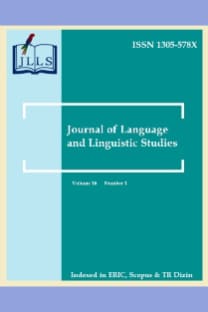Spor için metaforlarda yenilginin yaratıcı kullanımı: Çince yazılan NBA haber başlıklarının incelenmesi
The creative use of DEFEAT IS CONTROL in metaphors for sport: A study of NBA news headlines written in Chinese
___
- Aitchen, J. (1987). Words in the mind. Oxford: Blackwell.
- Arcimavičienė, L. (2008). Morality through metaphor: A cross-linguistic analysis of political discouerse. Kalbotyra 59, 11–19.
- Bergh, G. (2011). Football is war: A case study of minute-by-minute football commentary. Revista Veredas, 15(2). Retrieved on July 5, 2019 from https://periodicos.ufjf.br/index.php/veredas/article/view/25079
- Boyd, M. E. (2014). Riding the bench – A look at sports metaphors in judicial opinions. Harvard Journal of Sports & Entertainment Law, 5, 245–264.
- Brône, G., Feyaerts, K., & Veale, T. (2006). Introduction: Cognitive linguistic approaches to humor. Humor: International Journal of Humor Research, 19(3), 203–228. https://doi.org/10.1515/HUMOR.2006.012
- Charteris-Black, J. (2004). Corpus approaches to critical metaphor analysis. New York, NY: Palgrave Macmillan.
- Cudd, A. E. (2007). Sporting metaphors: Competition and the ethos of capitalism. Journal of the Philosophy of Sport, 34, 52–67.
- Fauconnier, G., & Turner, M. (2002). The way we think: Conceptual blending and the mind’s hidden complexities. New York, NY: Basic Books.
- Gibbs, R. W. (1999). Taking metaphors out of our heads and putting it into the cultural world. In R. W. Gibbs & G. Steen (Eds.), Metaphor in cognitive linguistics (pp. 145–166). Amsterdam: John Benjamins.
- Goatly, A. (1997). The language of metaphors. London and New York: Routledge.
- Goffman, E. (1974). Frame analysis: An essay on the organization of experience. Cambridge, MA: Harvard University Press.
- Grady, J. E., Oakley, T., & Coulson, S. (1999). Blending and metaphor. In R. W. Gibbs & G. Steen (Eds.), Metaphor in cognitive linguistics (pp. 101–124). Amsterdam: John Benjamins.
- Hidalgo-Downing, L. (2016). Metaphor and metonymy. In Rodney H. Jones (Ed.), The Routledge handbook of language and creativity (pp. 107–128). London and New York: Routledge.
- Kövecses, Z. (2005). Metaphor in culture: Universality and variation. New York, NY: Oxford University Press.
- Kövecses, Z. (2010a). Metaphor, Creativity, and Discourse. DELTA: Documentação e Estudos em Linguística Teórica e Aplicada, 26(3). Retrieved on October 1, 2019 from http://www.scielo.br/scielo.php?script=sci_arttext&pid=S0102-44502010000300016
- Kövecses, Z. (2010b). Metaphor: A practical introduction. Oxford: Oxford University Press.
- Kövecses, Z. (2015). Where metaphors come from: Reconsidering context in metaphor. Oxford and New York: Oxford University Press.
- Lakoff, G., Johnson, M. (1980). Metaphors we live by. Chicago: University of Chicago Press.
- Langlotz, A. (2016). Language, creativity, and cognition. In R. H. Jones (Ed.), The Routledge handbook of language and creativity (pp. 40–60). London and New York: Routledge.
- Lewandowski, M. (2009). Metaphors from other sports in the language of soccer – evidence from English and Polish. In P. Nowak & P. Nowakowski (Eds.), Język, Komunikacja, Informacja (Language, Communication, Information) (pp. 29–48). Poznań: Sorus.
- Lundmark, C. (2005). Metaphor and creativity in British magazine advertising. Unpublished PhD Dissertation, Luleå Tekniska Universitet, Luleå. Retrieved on April 28, 2019 from https://pdfs.semanticscholar.org/c744/d0a43b3b4abe5b4a1fda102f95f3325f9dd4.pdf?_ga=2.15967 5188.861762303.1571318576-1294420950.1514120294
- Molek-Kozakowska, K. (2013). Towards a pragma-linguistic framework for the study of sensationalism in news headlines. Discourse & Communication, 7, 173–197.
- Raffaelli, I., & Katunar, D. (2016). A discourse approach to conceptual metaphors: A corpus-based analysis of sports discourse in Croatian. Studia Linguistica Universitatis Iagellonicae Cracoviensis, 133, 125–147.
- Revised Chinese Characters Dictionary (2018). Retrieved on May 5, 2018 from: http://dict.revised.moe.edu.tw/cbdic/search.htm).
- Semino, E. (2008). Metaphor in discourse. Cambridge: Cambridge University Press. Semino, E. (2010). Unrealistic scenarios, metaphorical blends and rhetorical strategies across genres. English Text Construction, 3, 250–274.
- Shie, J.-S. (2011). Metaphors and metonymies in New York Times and Times Supplement news headlines. Journal of Pragmatics, 43, 1318–1334. https://doi.org/10.1016/j.pragma.2010.10.026
- Shields, D., & Bredemeier, B. (2011). Contest, competition, and metaphor. Journal of the Philosophy of Sport. 38.27–38.
- Silaški, N. (2009). Topic-triggered metaphors in newspaper headline. Professional Communication and Translation Studies, 2, 59–66.
- Sperber, D., & Wilson, D. (2008). A deflationary account of metaphors. In R. W. Gibbs (Ed.), The Cambridge Handbook of Metaphor and Thought (pp. 84–105). Cambridge: Cambridge University Press.
- Traugott, E. C. (1985). ‘'Conventional’ and ‘dead’ metaphors revisited. In W. Paprotté & R. Dirven (Eds), The ubiquity of metaphor: Metaphor in language and thought (pp. 17–57). Amsterdam: John Bejamins.
- Tseng, M.-Y. (2006). Iconicity in the interplay of the literal and metaphorical. Journal of Literary Semantics, 35, 31–57.
- Tseng, M._Y. (2007). Space metaphor as a signifying force in Chan poems. American Journal of Semiotics, 23, 221–241.
- ISSN: 1305-578X
- Yayın Aralığı: 4
- Başlangıç: 2005
- Yayıncı: http://www.jlls.org
Giyoto Giyoto, Novianni Anggraini, Elen Inderasari, Luthfie Arguby Purnomo
Türkçede uzun mesafeli çalkalama ve işletici taşıma
Yabancı dil olarak Türkçe öğretiminde argo üzerine öğretmen ve öğrenci görüşleri
Basılı metin en iyi seçim mi? Okuduğunu anlama üzerine karma yöntemli vaka çalışması
Yenilikçi Yalın Yöntemin yabancı dil öğreniminde incelenmesi
Ortaokul 8. sınıf öğrencilerinin akıllı tahta kavramına ilişkin algıları
TV dizilerinde kullanılan dil üzerine bir derlem incelemesi
Mustafa Serkan Öztürk, Hatice Sezgin
